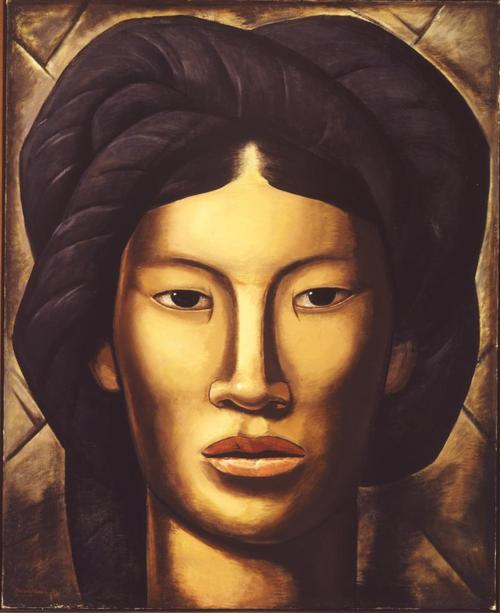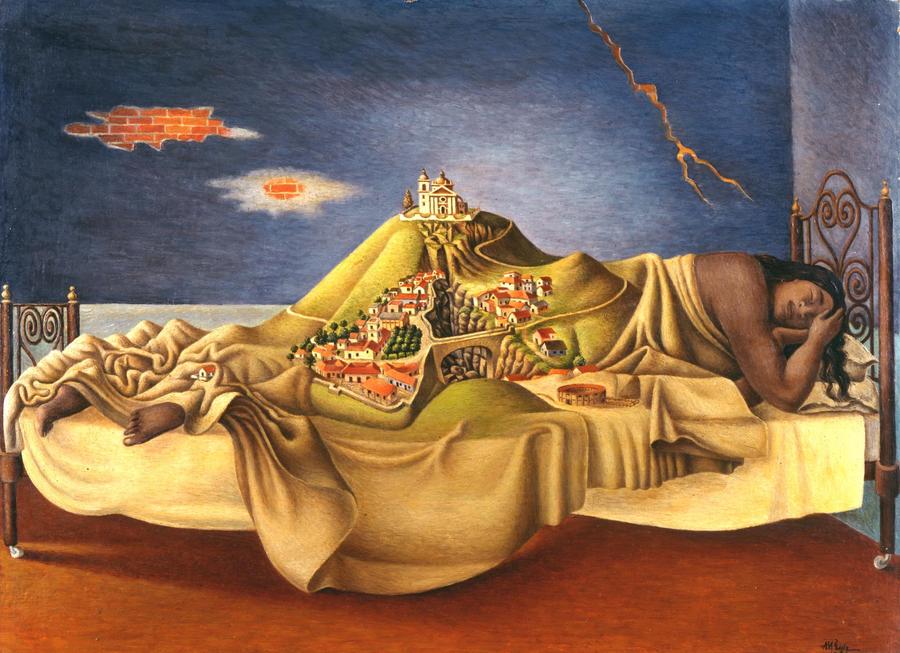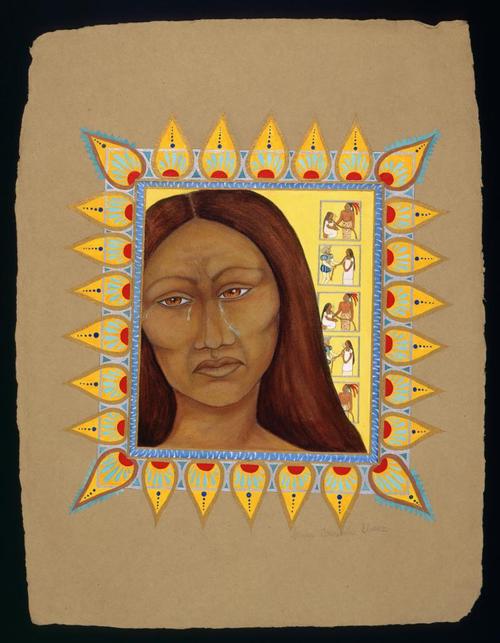Denver Art Museum
opening Feb. 6, 2022
Albuquerque Museum
June 11, 2022 through Sept. 4, 2022
San Antonio Museum of Art
Oct. 14, 2022, through Jan. 8, 2023
The Denver Art Museum (DAM) is planning Traitor, Survivor, Icon: The Legacy of La Malinche, an exhibition opening Feb. 6, 2022, that examines the historical and cultural legacy of La Malinche. Both reviled as a traitor and hailed as the mother of Mexico, Malinche is an enigmatic figure whose legacy has been the subject of controversy, legend and adulation from the 16th century through the present day.

Alfredo Ramos Martínez, La Malinche (Young Girl of Yalala, Oaxaca), 1940. Oil paint on canvas; 50 x 40 1/2 in. (127 x 103 cm). Phoenix Art Museum: Museum purchase with funds provided by the Friends of Mexican Art, 1979.86. ©The Alfredo Ramos Martínez Research Project, reproduced by permission.
An enslaved Indigenous girl who became Hernán Cortés’ interpreter and cultural translator, Malinche stood at center stage in one of the most significant events of modern history. She was a linguistically gifted protagonist who played a key role in the transactions, negotiations and conflicts between the Spanish and the Indigenous populations of Mexico that impacted the course of global politics for centuries to come. Significantly, as mother to Cortés’ first-born son she became the symbolic progenitor of a modern Mexican nation, built on both Indigenous and Spanish heritage.
While Malinche has been the subject of numerous historical publications and works of art, Traitor, Survivor, Icon is the first museum exhibition to present a comprehensive visual exploration of Malinche’s enduring impact on communities living on both sides of the U.S.-Mexico border. Five hundred years after her death, her image and legacy remain relevant to conversations around female empowerment, Indigeneity and national identity throughout the Americas. Traitor, Survivor, Icon will establish and examine her symbolic import and the ways in which artists, scholars, and activists through time have appropriated her image to interpret and express their own experiences and agendas from the 16th century through today.
Organized by the DAM and co-curated by Victoria I. Lyall, Jan and Frederick Mayer Curator of Art of the Ancient Americas at the DAM, and independent curator Terezita Romo, with Matthew H. Robb, Chief Curator at the Fowler Museum, UCLA, Traitor, Survivor, Icon will be on view in the Gallagher Family Gallery on level 1 of the museum’s Hamilton Building from Feb. 6, 2022, through May 8, 2022. It will then travel to the Albuquerque Museum, where it will be on view from June 11, 2022, through Sept. 4, 2022; and to the San Antonio Museum of Art from Oct. 14, 2022, through Jan. 8, 2023. The exhibition has been made possible in part by a major grant from the National Endowment for the Humanities.

"For five centuries Malinche has remained a contentious figure, revered and reviled on both sides of the Mexico-U.S. border," Lyall said. "She is a historical figure about which very little factual and biographical documentation exists. In examining and presenting the legacy of Malinche from the 16th century through today, we hope to illuminate the multifaceted image of a woman unable to share her own story, allowing visitors to form their own impressions of who she was and the struggles she faced."

Featuring 68 artworks created by 38 artists from Mexico, France and the U.S., Traitor, Survivor, Icon showcases perspectives from the 16th century through the present day, with two new commissions—a map of Malinche’s life by L.A.-based Chicana artist Sandy Rodriguez and a 21st-century interpretation of Malinche’s attire by Mexican fashion designer Carla Fernández—that will be revealed when the exhibition opens at the DAM in 2022. Two works from the DAM’s collection will be on view along with significant loans from institutions and private collectors. American lenders include the Brooklyn Museum, the Blanton Museum, The Metropolitan Museum of Art and Phoenix Museum of Art. Mexican lenders include the Museo Soumaya, the Museo Nacional de Antropología, the Museo del Calendario Mexicano and the Galería de Arte Mexicano.
The exhibition begins with a video to introduce Malinche and establish the historical, cultural, chronological and geographical contexts behind the invasion of the Spaniards and fall of the Aztec Empire. The exhibition will be thematically organized into five sections: La Lengua/The Interpreter, La Indígena/The Indigenous Woman, La Madre de Mestizaje/The Mother of a Mixed Race, La Traidora/The Traitor and "Chicana"/Contemporary Reclamations.
The first section, La Lengua, considers Malinche’s known historical role as translator and interpreter. Fluent in both Nahuatl and Mayan languages, she skillfully leveraged her linguistic gifts to survive, learning Spanish and quickly becoming indispensable to Cortés after she was given to him as an enslaved teenager following his landing in the region. The section La Indigena will establish visual signifiers of Indigeneity and roles that racialized standards of beauty played in the formation of modern Mexico. Alfredo Ramos Martinez’s luminous 1940 portrait of a young Indigenous woman titled La Malinche (Young Girl of Yalala, Oaxaca) will anchor this section, exploring the myriad ways artists have represented Indigeneity over the centuries. Ramos Martinez’s large-scale painting depicting Malinche and her unflinching gaze compels the viewer to engage with her.
The section La Madre de Mestizaje will present Malinche as the perceived mother of the hybrid mestizo identity of post-Conquest Mexico. La Traidora examines perceptions of her supposed treachery or cultural and ethnic betrayal in cooperating with the Spanish invaders. This section will feature Antonio Ruíz’s painting, El Sueño de la Malinche. The enormity and complexity of the story contained in Ruíz’s jewel-like painting is symbolic of the many allegories associated with La Malinche. Ruíz transforms Malinche’s body into a site of contestation and colonization, equated with the site of Cholula, entirely decimated by Cortés, and perhaps with Mexico itself, invaded by Spain, while she sleeps. The glowing beauty of this work with a dark connotation underscores the complex relationship contemporary Mexico still has with Malinche.
The final section of the exhibition, Chicana: Contemporary Reclamations, carries Malinche’s story into the 20th and 21st centuries when writers, creatives and artists began to reclaim Malinche as a survivor and an inspiration for Chicana and Mexicana artists. In this section, Malinche Tenía Sus Razones by Cecilia Concepción Alvarez employs Malinche’s image to explore issues of self-determination, self-representation and female spirituality. This work explores the complexity of Malinche’s story and asks the viewer to remember that she was left with little choice, but she survived and made the best of her perilous situation. In this painting, Malinche looks out at the viewer with tears running down her face. Behind her, the scenes of abuse create a powerful bridge between this woman and other women of color who have suffered abuse and trauma. An interactive visitor response area connected to the Chicana section will close out the exhibition, highlighting the unique and important connection between this presentation and Chicano culture in Denver, one of the epicenters of the Chicano movement and Chicano art in the U.S.
Because there is no record of Malinche’s story in her own voice, or even of her true name, Traitor, Survivor, Icon aims to examine the conditions that have led to the appropriation and adaptation of her image for the purposes of enacting cultural and political identities. This exhibition will examine the myriad of iterations to develop an understanding of Malinche and the meanings and roles that have been imposed upon her from her lifetime through the present moment.
"Traitor, Survivor, Icon will provide insights into the persona of Malinche, including her centrality to Mexican history and the ways in which her story resonates against our current cultural backdrop,” said Christoph Heinrich, Frederick and Jan Mayer Director of the Denver Art Museum. “Our fully bilingual exhibition presents Malinche’s generally unfamiliar and complex story to contemporary audiences through the work of artists across centuries and cultures, illuminating themes of identity, womanhood and agency that have sustained relevance across time."
Malinche’s position as a woman with privileged access to the predominantly male structures of political power on both sides of the Conquest prompts questions about the role of women in society then and now. As an Indigenous person, her participation and facilitation implicate her as complicit, rightly or wrongly, with the subjugation of her own people, surfacing issues of race and identity that echo in contemporary society.
"As a figure embraced by Chicana writers and artists," noted Terezita Romo, "Malinche is the subject of a narrative that had been reframed and recently invigorated to reflect a Chicana feminism that resists male dominated interpretations of her life and significance."
The timely exhibition also provides a moment to reflect on how the ideas of agency and identity that mark Malinche’s story remain relevant today.
The DAM is proud to partner with the University of Colorado Denver on a special interactive element within the exhibition that will allow visitors to digitally explore via touchscreen the Museum’s recently acquired 100-foot-long Tillett Tapestry depicting Cortés’ 36-month campaign. The DAM has formed additional partnerships with art and community organizations for in-gallery and other public programs including the University of Denver.
As the first exhibition to explore the subject visually, Traitor, Survivor, Icon will be accompanied by a fully illustrated catalog that will explore in depth the context and history of Malinche and will follow the exhibition’s sections while elaborating more fully on thematic ideas. Contributing authors include Terezita Romo, Victoria I. Lyall and Jesse Laird Ortega, Camilla Townsend, Alicia Gaspar de Alba, Charlene Villaseñor Black, Sandra Messinger Cypess, Luis Vargas-Santiago, Ines Hernández-Ávila, Lisa Sousa, Emmanuel Ortega and Karen Cordero Reiman. The catalog, published by Yale University Press, will be available in The Shop at the Denver Art Museum and via its online store.
Traitor, Survivor, Icon will be included in general museum admission, which is free daily for youth 18 and under as well as museum members. Upon opening, please check the museum’s website at denverartmuseum.org for the museum’s latest ticketing policies and procedures. Those sharing content on social media are encouraged to use #MalincheatDAM.